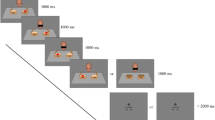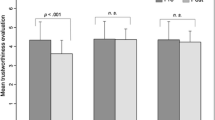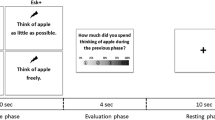Abstract
Understanding others mind and interpersonal interaction are the cognitive basis of successful social interactions. People’s mental states and behaviors rely on their holding beliefs for self and others. To investigate the neural substrates of false belief reasoning, the 32 channels event-related potentials (ERP) of 14 normal adults were measured while they understood false-belief and true belief used deceptive appearance task. After onset of the false-belief or true-belief questions, N100, P200 and late negative component (LNC) were elicited at centro-frontal sites. Compared with true belief, false belief reasoning elicited significant declined LNC in the time window from 400 to 800 ms. The source analysis of difference wave (False minus True) showed a dipole located in the middle cingulated cortex. These findings show that false belief reasoning probably included inhibitive process.
Similar content being viewed by others
References
Premack D, Woodruff G. Does the chimpanzee have a ‘theory of mind’? Behav Brain Sci, 1978, 4: 515–526
Wang Y W, Zhang W X. Development of theory-of-mind of 3–6 years old children. Psychol Dev Educat (in Chinese), 2002, 18(1): 11–16
Wang Y W, Lin C D. Experimental tasks of theory-of-mind and its research tendency. Psychol Explor (in Chinese), 2004, 23(3): 30–34
Wang Y W, Lin C D, Zhang W X. The task analysis of appearance-reality distinction, representational change and false belief. Psychol Sci (in Chinese), 2003, 26(3): 390–392
Zhang W X, Zhao J X, Wang Y W, et al. Development of attribution of second-order false-belief by 3-to-6-year-old children. Acta Psychol Sin (in Chinese), 2004, 36(3): 327–334
Wang Y W, Zhang W, Lu Z H, et al. The primary analysis of the neural substrates of the theory-of-mind. Acta Psychol Sin (in Chinese), 2005, 37: 955–959
Wang Y W, Lin C D, Lu Z H. Research progress in developmental cognitive neuroscience. Prog Nat Sci (in Chinese), 2006, 16(12): 1530–1535
Liu Y, Zhang W, Chen J, et al. The Neural mechanism of theory-of-mind: evidences from brain imaging. Psychol Sci (in Chinese), 2007, 30(3): 763–765
Wang Y W, Chen G H, Liu Y, et al. Application of the neuroimaging in development of psychology. Prog Nat Sci (in Chinese), 2007, 17(5): 603–608
Frith C D, Frith U. Interacting minds-A biological basis. Science, 1999, 286(5445): 1692–1695
Gallagher H L, Frith C D. Functional imaging of ‘theory of mind’. Trends Cogn Sci, 2003, 7(2): 77–83
Frith U, Frith C D. Development and neurophysiology of mentalizing. Philosoph Transactions Royal Soc London Ser B-Biol Sci, 2003, 358(1431): 459–473
Amodio D M, Frith C D. Meeting of minds: the medial frontal cortex and social cognition. Nat Rev Neurosci, 2006, 7(4): 268–277
Gallagher H L, Happe F, Brunswick N, et al. Reading the mind in cartoons and stories: An fMRI study of ‘theory of the mind’ in verbal and nonverbal tasks. Neuropsychologia, 2000, 38(1): 11–21
Saxe R, Kanwisher N. People thinking about thinking people: the role of the temporo-parietal junction in “theory of mind”. NeuroImage, 2003, 19(4): 1835–1842
Saxe R, Wexler A. Making sense of another mind: The role of the right temporo-parietal junction. Neuropsychologia. 2005, 43(10): 1391–1399
Pelphrey K A, Morris J P, McCarthy G. Grasping the Intentions of others: The perceived intentionality of an action influences activity in the superior temporal sulcus during social perception. J Cogn Neurosci, 2004, 16(10): 1706–1716
Sabbagh M A, Taylor M. Neural correlates of theory-of-mind reasoning: an event-related potential study. Psychol Sci, 2000, 11(1): 46–50
Liu D, Sabbagh M A, Gehring W J, et al. Decoupling beliefs from reality in the brain: An ERP study of theory of mind. NeuroReport, 2004, 15(6): 991–995
Sabbagh M A, Moulson M C, Harkness K L. Neural correlates of mental state decoding in human adults: An event-related potential study. J Cogn Neurosci, 2004, 16(3): 415–426
Fletcher P C, Happe F, Frith U, et al. Other minds in the brain: A functional imaging study of ‘theory of mind’ in story comprehension. Cognition. 1995, 57(2): 109–128
Leslie A M, Polizzi P. Inhibitory processing in the false belief task: Two conjectures. Dev Sci, 1998, 1(2): 247–253
Leslie A M, Friedman O, German T P. Core mechanisms in ‘theory of mind’. Trends Cogn Sci, 2004, 8(12): 528–533
Vogeley K, Bussfeld P, Newen A, et al. Mind reading: Neural mechanisms of theory of mind and self-perspective. NeuroImage, 2001, 14(1): 170–181
Decety J, Jackson P L, Sommerville J A. The neural bases of cooperation and competition: An fMRI investigation. NeuroImage 2004, 23(2): 744–751
McCabe K, Houser D, Ryan L, et al. A functional imaging study of cooperation in two-person reciprocal exchange. Proc Natl Acad Sci USA, 2001, 98(20): 11832–11835
Gallagher H L, Jack A I, Roepstorff A, et al. Imaging the intentional stance in a competitive game. NeuroImage, 2002, 16(3): 814–821
Botvinick M M, Cohen J D, Carter C S. Conflict monitoring and anterior cingulate cortex: an update. Trends Cogn Sci, 2004, 8(12): 539–546
Weissman D H, Giesbrecht B, Song A W, et al. Conflict monitoring in the human anterior cingulate cortex during selective attention to global and local object features. NeuroImage, 2003, 19(4): 1361–1368
Author information
Authors and Affiliations
Corresponding authors
Additional information
Supported by the National Natural Science Foundation of China (Grant No. 30700238), the National Social Science Foundation of China (Grant No. CBA060059), the Taishan Scholars Construction Project and the State Key Laboratory of Cognitive Neuroscience and Learning
Rights and permissions
About this article
Cite this article
Wang, Y., Liu, Y., Gao, Y. et al. False belief reasoning in the brain: An ERP study. Sci. China Ser. C-Life Sci. 51, 72–79 (2008). https://doi.org/10.1007/s11427-008-0014-z
Received:
Accepted:
Issue Date:
DOI: https://doi.org/10.1007/s11427-008-0014-z




